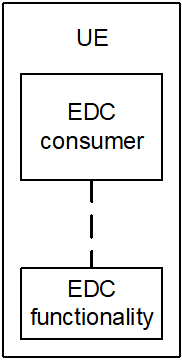Content for TS 23.548 Word version: 18.6.0
1…
4…
4.3
5…
6…
6.2.2.3…
6.2.3…
6.2.3.2.3…
6.2.3.2.5…
6.2.3.3…
6.3…
6.4…
6.5…
6.6
6.7…
6.7.2.4…
6.7.2.6…
6.7.3…
6.8…
7…
A
B…
F…
5 Functional Description for Supporting Edge Computing
5.1 EASDF
5.1.1 Functional Description
5.1.2 EASDF Discovery and Selection
5.2 Edge DNS Client (EDC) Functionality
5.2.1 Functional Description
...
...
5 Functional Description for Supporting Edge Computing p. 11
5.1 EASDF p. 11
5.1.1 Functional Description p. 11
The Edge Application Server Discovery Function (EASDF) includes one or more of the following functionalities:
- Registering to NRF for EASDF discovery and selection.
- Providing DNS security information to SMF.
-
Handling the DNS messages according to the instruction from the SMF, including:
- Receiving DNS message handling rules and/or BaselineDNSPattern from the SMF.
- Exchanging DNS messages from the UE.
- Forwarding DNS messages to C-DNS or L-DNS for DNS Query.
- Adding EDNS Client Subnet (ECS) option into DNS Query for an FQDN.
- Reporting to the SMF the information related to the received DNS messages.
- Buffering/Discarding DNS messages from the UE or DNS Server.
- Providing a DNS response with a specific IP address to a DNS query.
- Constructing and sending DNS Query messages with specific FQDN and ECS option.
- Terminates the DNS security, if used.
5.1.2 EASDF Discovery and Selection p. 12
The EASDF discovery and selection is defined in clause 6.3 in TS 23.501.
5.2 Edge DNS Client (EDC) Functionality p. 12
5.2.1 Functional Description p. 12
The Edge DNS Client (EDC) functionality is a 3GPP functionality in the UE that ensures that DNS requests from applications are sent to the DNS Server's (e.g. EASDF/DNS resolver) IP address received from the SMF in the ePCO. The EDC functionality in the UE is a UE capability that ensures the usage of the EAS discovery and re-discovery functionalities defined in clause 6.2.
Figure 5.2-1 depicts the Edge DNS Client (EDC) functionality in the UE.

A UE that hosts the EDC functionality indicates its capability in the PCO during the PDU Session Establishment and the PDU Session Modification procedures. The EDC functionality includes the following functionalities:
- Configures the DNS Client with the DNS Server's configuration (IP address and, conditionally, DNS security information of the EASDF/DNS resolver; see TS 24.501 and TS 33.501) received from the SMF in the ePCO according to clause 5.6.10.1 of TS 23.501.
-
DNS Client:
- Provides the capability to the consumer in the UE to resolve FQDN using DNS Queries towards the DNS Server (e.g., EASDF/DNS resolver) indicated by the SMF.
- Sends DNS Queries towards the DNS Server indicated by the SMF via the related PDU session.
- Forwards EAS IP addresses and other relevant information included in the DNS responses received from the DNS Server to the consumer in the UE.
-
Provision of DNS settings (Optional):
- Provides to the consumer in the UE the configuration of the DNS Server (IP address and, conditionally, DNS security information of the EASDF/DNS resolver; see TS 24.501 and TS 33.501) received from the SMF. The consumer in the UE can explicitly request the DNS Server's configuration and/or can subscribe/unsubscribe to receive updates of the DNS Server's configuration.
- the application mapped onto the PDU Session explicitly requests the use of the EDC functionality and the SMF indicated, at PDU Session Establishment or at PDU Session Modification, that the use of the EDC functionality is allowed for that PDU session; or
- the SMF indicated, at PDU Session Establishment or at PDU Session Modification, that the use of the EDC functionality is required for the PDU Session for the specific DNN. In this case, the UE shall use the EDC functionality for all the applications mapped onto that PDU Session.